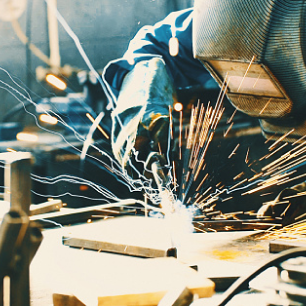Jump to:
The Answer Is
Q: I’m a new Certified Welding Inspector (CWI) working with a fabricator as a welder. I started my career as a welder, but I don’t want to limit myself to being a welder forever. It seemed like passing the CWI would be a good way of advancing my career. The CWI seminar covered a lot of interesting material, but it was new to me. I have a question about fatigue and its importance to a welder or an inspector. I would like to learn more about the subject and how it affects welding and inspection. Can you explain briefly about the subject and the sketches showing where cracks are likely to form and what the graph is all about? The instructor touched on the topic during the CWI review, but I didn’t absorb everything.
A: The subject of fatigue is tough to cover in 100 words or less, so strap yourself in. This is going to take some time to cover.
Fatigue is the accumulated damage that occurs when a connection or member (i.e., a beam or girder) is subjected to cyclic loading. A member or connection subjected to a load that fluctuates over time can develop cracks that ultimately lead to a structural collapse. When the cyclic load exceeds a threshold value, a small amount of damage results. Over time, the damage accumulates and initiates a crack. With additional load cycles, the crack continues to propagate slowly at first, but the crack growth rate increases with additional cycles of loading and unloading.
To illustrate the principle, imagine you grasp a length of steel wire at opposite ends. Now, you bend the wire back and forth. Eventually, the length of the wire will break, and you will have two pieces of wire. Each time you bend the wire one way or the other, it is considered to be a load cycle. The bending increases the unit stress inside and outside the bend radii. The outside bend radius is loaded in tension, and the inside bend radius is loaded in compression. As you bend the wire in the opposite direction, the nature of the extreme fiber stress is reversed. What was in tension is now in compression; what was in compression is now in tension. With each cycle of bending, some damage is incurred by the wire. Eventually, the wire will break. If the radius of the bend is large, the magnitude of the extreme fiber stress is low, and the number of load cycles will be high before failure occurs. If the bend radius is small, the unit stress at the outside and inside radii are high, and fewer load cycles are necessary to cause the wire to break.
Now, change the conditions of our wire experiment slightly. Add a small notch near the mid-length of the wire and bend the wire back and forth. You will notice the bend will center on the notch. The magnitude of the unit stress at the notch will be higher than in the un-notched wire, and the bend radius will be much smaller. It will take fewer cycles of bending the wire back and forth to cause it to break. It takes fewer load cycles because of the stress intensification due to the presence of the small notch. Geometric features like welding members of different thicknesses or widths, undercuts, or overlaps act like the notch in the wire. They magnify the stress in the area of the changing geometry. Notches are often called stress risers because the stresses are concentrated at the notch.
Another consideration is how materials respond to a force or applied load. This wire experiment differentiates between elastic behavior and plastic behavior. For this demonstration, we use a length of wire without a notch and extend the wire several inches beyond the edge of a table. Apply a small load to the far end of the wire extending over the table’s edge. You will observe the end of the wire deflecting in the direction of the applied load. Remove the load, and the wire springs back to its original position. This is an example of elastic behavior. Increase the load by a small amount, and the wire will deflect more. With each increase in load, the deflection will be greater, but the wire springs back to its original position. Eventually, the load will be large enough that the wire will deflect, but when the load is removed, the wire will not return to its original position; we see that the wire is permanently deflected or deformed. The wire is now exhibiting plastic behavior. The unit stress at the outside of the bend radius has exceeded the yield strength of the wire, so the wire does not spring back to its original position. While the deflection caused by the load within the elastic range is recoverable, the portion of the load above the yield point (in the plastic range) is not recoverable because the atoms in the area of the bend have slipped past each other, resulting in a permanent bend.
Modify the experiment by making a small notch in the wire at about mid-length and position the wire so the notch is located just beyond the edge of the table. The load required to cause the wire to permanently bend (i.e., the load required to cause the unit stress in the area of the notch to exceed the material’s yield point) is less than the wire without the notch. It takes less load to cause the wire to bend because of two factors: first, the notch reduces the cross-sectional area, and, second, the notch acts as a stress intensifier.
What’s the connection between the demonstrations just completed and fatigue cracking? We learned that at low loads where the unit stress is within the elastic range, the wire with a constant diameter (i.e., no notches) can undergo many cycles of loading and unloading before (if ever) a crack initiates and, ultimately, the wire fractures. However, when the geometry is changed with the introduction of a notch, the wire will fail after fewer load cycles. The notch represents a change in geometry that multiplies the unit stress, possibly into the plastic range, because the notch is said to be a stress riser. The unit stress in the area of the notch is several times higher than it is for the un-notched wire. Weld discontinuities and abrupt changes in geometers are often called notch-like stress risers because their influence is very similar to the notch in the wire.
How does all this relate to fatigue cracking? That’s a good question. The wire experiments demonstrate some factors that influence the probability of fatigue cracks developing when a weldment is placed into service.
Factors that influence fatigue life of a connection are as follows:
- The magnitude of the load that is subject to change,
- The number of load cycles, and
- The geometry of the connection.
- It’s time to get into the thick of it.
AWS D1.1/D1.1M, Structural Welding Code — Steel, provides guidelines to the designer for determining if fatigue is a design consideration. The clause covering fatigue is more extensive now than it was 40 years ago. The first thing that needs to be determined is whether the magnitude of the fluctuating load exceeds a threshold value. In other words, the load that changes must be large enough to be a concern. In the case of a bridge, a car passing over the bridge represents a changing load, but it is rather inconsequential. What is concerning is the number of fully laden trucks or loaded rail cars passing over the bridge. The passenger car might weigh 5000 lb (5 kips), but the fully loaded truck weighs 50,000 lb (50 kips), and the loaded rail car might weigh in at 80,000 lb (80 kips). The magnitude of the changing load is due to the car being below the threshold value, so fatigue is not a concern. However, the magnitude of the changing load that results when the loaded truck or rail car is above the threshold value is a concern. After a sufficient number of load cycles, the accumulated damage can result in one or more cracks. The location of the cracks will most likely be where there is a notch-like
discontinuity.
AWS D1.1 also categorizes the welded connections into stress categories. They include butt joints, T-joints, corner joints, complete joint penetration groove welds with the backing left in place, complete joint penetration groove welds with the backing removed, etc. They are grouped as Category A, Category B, through Category F. The sketches of the various welded connections are included in Fig. 1. The higher the letter value, the more likely fatigue cracking is a problem.
These figures are used in conjunction with the S-N plots depicted in Figure 4.16, which are also found in AWS D1.1 — see Fig. 2. In this case, the plots only apply to nontubular connections.
The magnitude of the cyclic load does not include the dead load of the member being investigated. In the case of a simple span, the load changes over time due to the live load (e.g., a loaded truck moving across a single-span bridge deck). If the bridge is a continuous span extending over more than two supports, the magnitude of the load is the absolute value of the cyclic load that reverses (the sum of both compression and tension without regard to the mathematical sign of the load).
The designer determines what stress category applies to the connection being designed. AWS D1.1 has several formulae the designer uses to compare the magnitude of the cyclic load to the threshold value (Fth) assigned to the connection. If the threshold value is exceeded, fatigue must be considered.
A moment connection in an office building must support the dead loads of the steel frame and the concrete deck, but the connection will be subjected to an increased load during a snowstorm. The unit stress due to the snow load might increase to something above 30 ksi during a major snowstorm. The increased load will disappear as the snow melts. Assume the moment connection is a stress category C connection. The threshold value is 10 ksi, and it is exceeded during each snowstorm. Assuming there are three months of winter and there is one major snowstorm per week, there would be 12 major snowstorms each year, with each snowstorm representing one 30 ksi cyclic load. It would take 180,000/12 = 15,000 years before a fatigue crack would form. Office buildings, hotels, schools, etc., are considered statically loaded and are not expected to experience issues with fatigue cracking. They have a useful life that is much too short to experience fatigue.
Change the structure to a bridge where automobiles and fully laden trucks pass over it. The magnitude of the cyclic load due to the automobiles is less than the threshold value of 10 ksi. Thousands of automobiles pass over the bridge on any given day, but they will not generate the stresses necessary to produce fatigue cracks. However, fully loaded trucks are another story. Each truck represents a cyclic load of 30 ksi, well above the threshold value. Should enough trucks pass over the bridge, fatigue cracks will result. For our example, five trucks per hour pass over the bridge between 6:00 a.m. and 6:00 p.m. Between 6:00 p.m. and 6:00 a.m., only one truck per hour passes over the bridge. In total, 72 trucks pass over the bridge per day, or 504 trucks per week. It would take 357 weeks to reach 180,000 cyclic loads or about 6.8 years before fatigue cracks could be expected to initiate. At first, the cracks would propagate slowly, but in short order, the growth rate, being exponential, would lead to failure.
As the bridge approaches the expected 180,000 load cycles, inspection should be conducted more frequently so the cracks are detected while they are still small, and there is time to develop a repair plan. An inspection plan will typically include more frequent inspections to ensure the repairs are undertaken before the cracks reach a critical size, causing the bridge to collapse.
I hope this explains how the S-N graph helps the designer consider cyclic loads and the potential for developing fatigue cracks.
The inspector needs to know whether the weldment is a statically or cyclically loaded structure so the correct acceptance criteria is used for the inspections. If the inspector is performing in-service inspections, the Table 4.5 sketch shows the inspector what areas need close scrutiny to detect cracks in the early stages of forming.
It is unlikely the fatigue crack is going to develop near the midpoint of a beam unless there is a change in geometry (i.e., the width or thickness changes) or there is a geometric feature like a gouge or a butt joint that wasn’t ground smooth. However, the toes of the welds of a moment connection are a location that is likely to develop fatigue cracks if the weld contains notch-like discontinuities such as an undercut, overlap, or slag inclusion or the weld is backgouged with incomplete joint penetration, etc. But do not overlook the fact that the toes of welded T-joints are naturally notch-like stress risers and prone to developing fatigue cracks. Often overlooked is the presence of a mislocated hole that was repaired by welding. The inspector may not be aware of repaired holes, or they may be ground flush and easily overlooked. A mislocated hole incorrectly repaired by welding is a fatigue crack waiting to happen.
I hope I have given you some information about how the S-N graphs are used, how some connections are more tolerant of cyclic loads, and how geometric features can influence the longevity of a structure. The connections that have the lowest threshold values (Fth) are the connections most likely to develop fatigue cracks, and welds that have notch-like discontinuities are most likely to develop fatigue cracks. In comparison, welds that are ground smooth and welds that are free of stress risers are more resistant to fatigue cracks.
Structures are only as strong as their weakest link. Those connections that are more prone to developing fatigue cracks must be closely monitored as they approach their useful life. As an inspector, you can use the information provided by AWS D1.1 to inspect steel better as it’s being fabricated and perform more productive in-service inspections.
ALBERT J. MOORE JR. (amoore999@comcast.net) is president and owner of NAVSEA Solutions/Marion Testing & Inspection, Burlington, Conn. He is an AWS Senior Certified Welding Inspector and an ASNT NDT Level III. He is also a member of the AWS Qualification & Certification Committee on Methods of Inspection.
The Society is not responsible for any statements made or opinions expressed herein. Data and information developed by the authors are for specific informational purposes only and are not intended for use without independent, substantiating investigation on the part of potential users.


